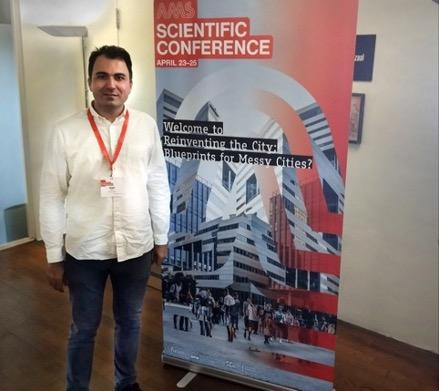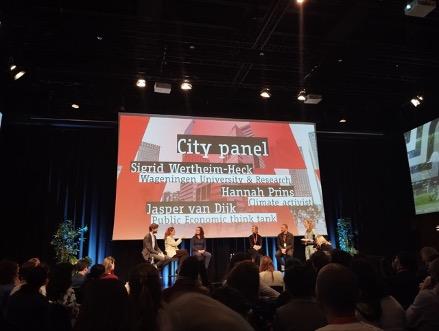Dr. Saleh Roshani is one of the Centre for BOLD Cities visiting researchers. At our Centre, he researches the changes in the role of urban planners affected by the urban data revolution. In April, he visited the AMS Scientific Conference “Reinventing the City: Blueprint for Messy Cities". He wrote a report on his experiences at the conference, which can be read here.

Last week, I had the opportunity to attend the AMS Scientific Conference “Reinventing the City: Blueprint for Messy Cities". The event brought together a diverse group of scientists, policymakers, industry leaders, and students, all with a shared focus on shaping the future of our cities through the lens of smart technologies, digitalization, and social equity.
Messiness and Innovation
The AMS Conference revolved around two main concepts: messiness and innovation, and how innovation can address urban messiness. Based on the insights shared by participants and the topics discussed, each can have different and sometimes opposing meanings. The term "messiness" can be viewed in two ways: negatively, referring to the chaos, diseases, and unrest occurring in cities, or positively, referring to the spontaneous and complex order of cities. The current trend in innovation is to focus on technology-driven solutions. but there is also a growing emphasis on how different stakeholders can interact toward a more inclusive and socially responsible future.
The current trend in innovation is to focus on technology-driven solutions. but there is also a growing emphasis on how different stakeholders can interact toward a more inclusive and socially responsible future".
One of the speakers, Ger Baron, expressed a positive view of messiness as a catalyst for creativity and innovation. He believed that piecemeal solutions could repeatedly adapt to complex realities, making cities more vibrant and adaptable. This perspective contrasts with the rational decision-making approach taken by urban planners in the mid-20th century, which resulted in uniformity, loss of community and identity, and neglect of the human scale. Therefore, in this sense, messiness can help create more social interaction and adaptable cities.
There are urgent questions about the capability of innovations to help us tackle the most pressing threats, like climate change, for cities. The conference's first keynote speaker, Paul Behrens, highlighted that our perception of the severity of climate change impacts has changed in the last two decades. We now recognize that even slight increases in global temperature can lead to severe consequences, impacting food security and political stability. However, projections show that the rate of greenhouse gas emissions is decreasing, and the pace of energy transition has been faster than initially expected. Additionally, cities are implementing policies for sustainable urban transport and buildings.
A Three-Day Journey of the Conference
On the first day, the focus was on unveiling the challenges faced by urban environments. The day started with a critical examination of the complexities involved in integrating technology into our cities. Paul Behrens, the keynote speaker, emphasized the need for a nuanced approach that considers the social implications of technological solutions. This theme was further explored by Elin Andersdotter Fabre of UN-Habitat's Her City initiative, who highlighted the critical role of empowering women in the digital transformation of cities. In the afternoon, I attended two sessions. The first one focused on how citizens' experiences in urban spaces have changed in the digital age. The second session, titled "Data for Inclusivity," provided insightful perspectives on how citizens and governments interact within urban systems.

Day two started with the exciting world of smart city solutions. Carlo Ratti from MIT discussed the concept of cities as living labs where digital technologies can be tested with real-time feedback from citizens. The question of whether the expansion of technologies and the discovery of new measurement possibilities for urban systems can deepen the relationship between citizens and governments was raised. Sacha Stolp from the city of Amsterdam emphasized the need to learn from nature, technology, and each other. The city panel discussion focused on what kinds of innovation are needed and what roles different actors play. It was interesting to see different perspectives emerge from the panel members, showcasing how diverse groups can offer innovative solutions in their respective fields if shared values and goals can be defined.
It was interesting to see different perspectives emerge from the panel members, showcasing how diverse groups can offer innovative solutions in their respective fields if shared values and goals can be defined."
The last day emphasized the importance of stakeholder engagement in creating a socially responsible digital future for our cities. Victor Neequaye Kotey's presentation from the Accra Metropolitan Assembly highlighted some of the contextual differences in urban issues. He highlighted the challenges faced by rapidly growing cities in the digital age. Informality, a key feature of large African cities, resonated throughout his talk. Urban planning expert Paul Chatterjee presented a Guide for Emergency Action to Save Cities, a post-growth model for smart cities that outlines how we can learn, act, and build step by step.
After attending sessions focused on digital tools and how to make them more inclusive on afternoons of days one and two, I participated in a session titled Nurturing Cities on the afternoon of day three to gain a broader perspective. Egbert Stolk's interesting work, focused on theory formation, emphasized an ongoing interaction between the three contexts of everyday life, professional practice, and academia. Similarly, Gert Jan Hofstede called for an interdisciplinary approach by raising the problems of growth-oriented economic models, which should benefit all urban inhabitants. Finally, in the last conference program, I participated in the Digital Tools for Cities session where I again looked for answers to my main questions at a more granular level and about the digital tools being developed for cities. This session's tool-related research included the Urban Diversity Robot, the role of citizens in urban planning in the datafied space, the design of urban technology interfaces, and finally, the analysis of urban nature.
Reflections and Questions
The technological world is advancing rapidly towards creating digital twins of cities which is attracting significant research attention. Still, an important portion of research reflects current values and concerns. Sustainability is a prominent theme, with projects focusing on zero-emission logistics, inclusive mobility, circular buildings, and nature-based solutions (NBS). All these rapid changes raise new questions regarding the relationship between citizens and governments mediated by digital tools. Beyond the current focus on technology-driven urban innovation and digital twins, some researchers take a more critical perspective. They explore radically different digital futures and question the feasibility of endless digitalization. Despite a prevailing emphasis on innovation and technological progress, the conference highlighted the increasing importance of collaboration and citizen engagement in building more inclusive and sustainable future cities.
Two key aspects emerge from these discussions for citizen-government relations. First, a growing technology-driven movement seeks to leverage innovative tools to improve these relations. It prioritizes specific tasks, such as developing new applications, enhancing existing ones, evaluating current systems, and identifying practical, small-scale solutions. Second, the rapid changes in the digital age necessitate a broader view of the transformation: a more comprehensive understanding of the process, its impact on existing systems, potential future scenarios, and alternative solutions. These underscore the primary concerns of BOLD Cities in a rapidly digitalizing world.
